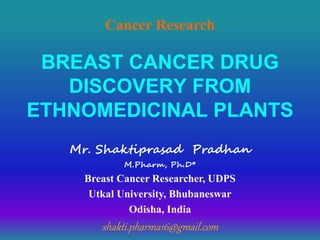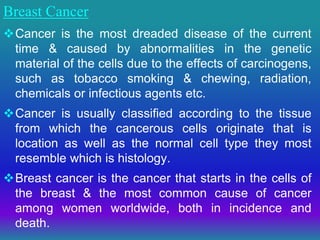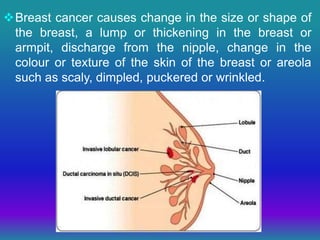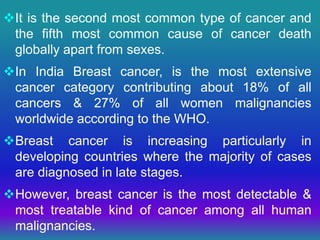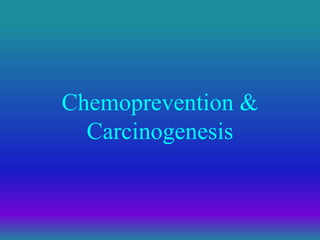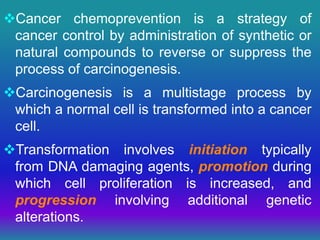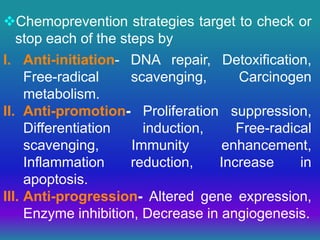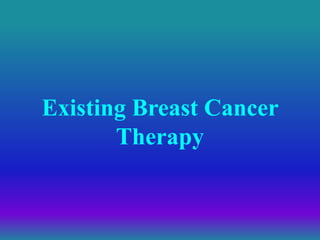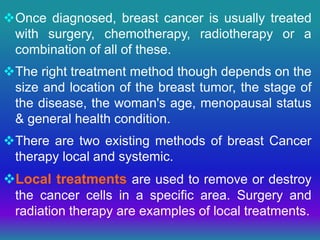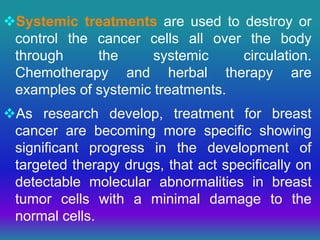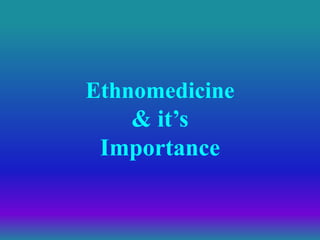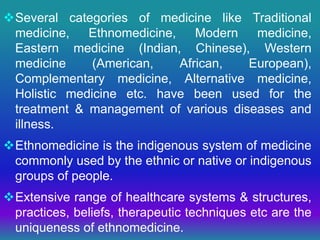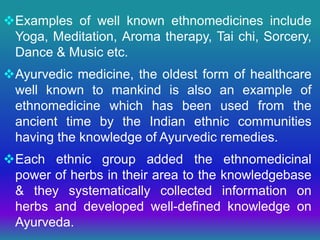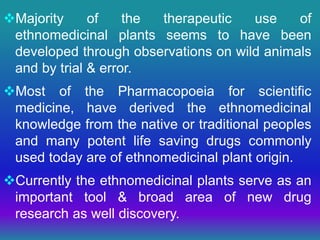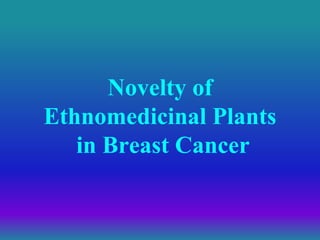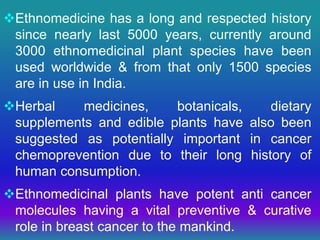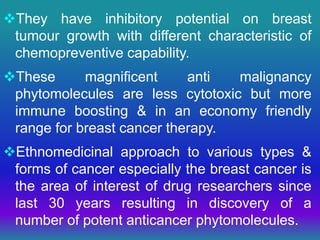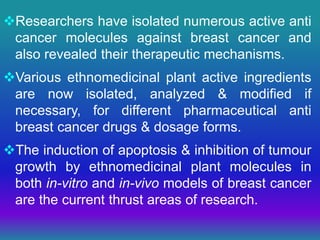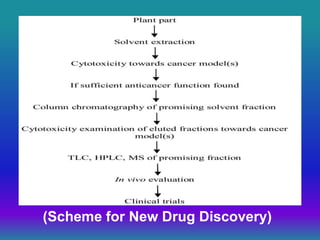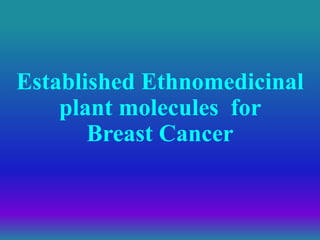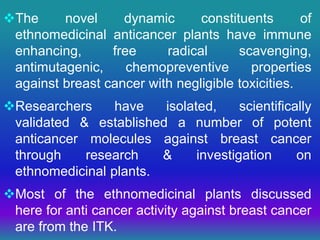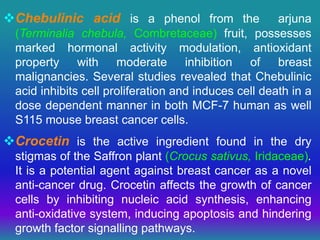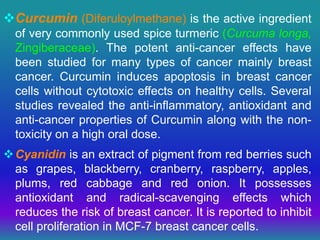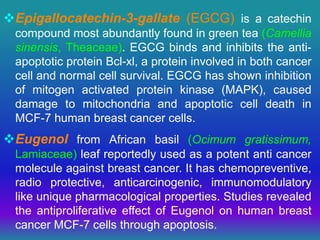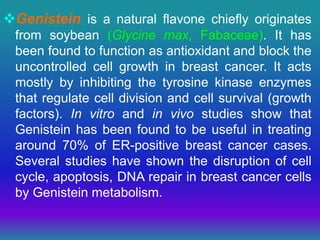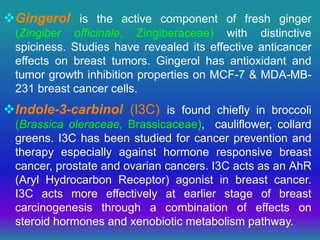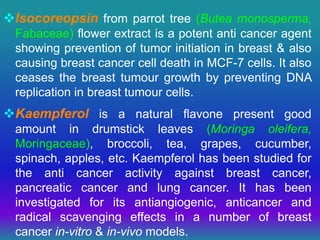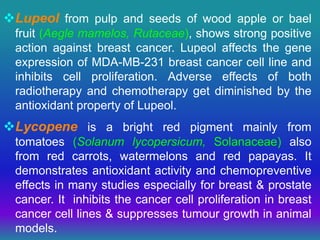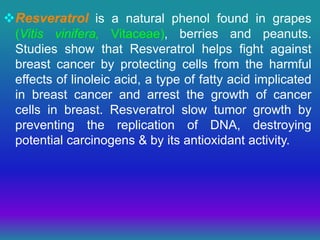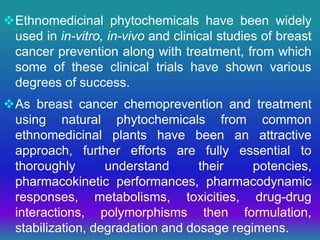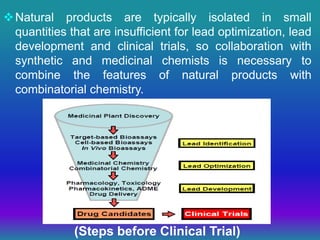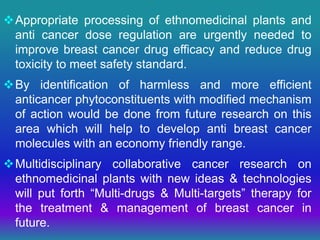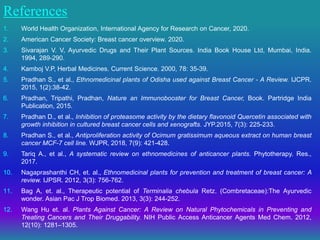Breast Cancer Drug Discovery From Ethnomedicinal Plants
- 1. BREAST CANCER DRUG DISCOVERY FROM ETHNOMEDICINAL PLANTS Mr. Shaktiprasad Pradhan M.Pharm, Ph.D* Breast Cancer Researcher, UDPS Utkal University, Bhubaneswar Odisha, India shakti.pharma16@gmail.com Cancer Research
- 3. Breast Cancer Cancer is the most dreaded disease of the current time & caused by abnormalities in the genetic material of the cells due to the effects of carcinogens, such as tobacco smoking & chewing, radiation, chemicals or infectious agents etc. Cancer is usually classified according to the tissue from which the cancerous cells originate that is location as well as the normal cell type they most resemble which is histology. Breast cancer is the cancer that starts in the cells of the breast & the most common cause of cancer among women worldwide, both in incidence and death.
- 4. Breast cancer causes change in the size or shape of the breast, a lump or thickening in the breast or armpit, discharge from the nipple, change in the colour or texture of the skin of the breast or areola such as scaly, dimpled, puckered or wrinkled.
- 5. It is the second most common type of cancer and the fifth most common cause of cancer death globally apart from sexes. In India Breast cancer, is the most extensive cancer category contributing about 18% of all cancers & 27% of all women malignancies worldwide according to the WHO. Breast cancer is increasing particularly in developing countries where the majority of cases are diagnosed in late stages. However, breast cancer is the most detectable & most treatable kind of cancer among all human malignancies.
- 7. Cancer chemoprevention is a strategy of cancer control by administration of synthetic or natural compounds to reverse or suppress the process of carcinogenesis. Carcinogenesis is a multistage process by which a normal cell is transformed into a cancer cell. Transformation involves initiation typically from DNA damaging agents, promotion during which cell proliferation is increased, and progression involving additional genetic alterations.
- 8. Chemoprevention strategies target to check or stop each of the steps by I. Anti-initiation- DNA repair, Detoxification, Free-radical scavenging, Carcinogen metabolism. II. Anti-promotion- Proliferation suppression, Differentiation induction, Free-radical scavenging, Immunity enhancement, Inflammation reduction, Increase in apoptosis. III. Anti-progression- Altered gene expression, Enzyme inhibition, Decrease in angiogenesis.
- 10. Once diagnosed, breast cancer is usually treated with surgery, chemotherapy, radiotherapy or a combination of all of these. The right treatment method though depends on the size and location of the breast tumor, the stage of the disease, the woman's age, menopausal status & general health condition. There are two existing methods of breast Cancer therapy local and systemic. Local treatments are used to remove or destroy the cancer cells in a specific area. Surgery and radiation therapy are examples of local treatments.
- 11. Systemic treatments are used to destroy or control the cancer cells all over the body through the systemic circulation. Chemotherapy and herbal therapy are examples of systemic treatments. As research develop, treatment for breast cancer are becoming more specific showing significant progress in the development of targeted therapy drugs, that act specifically on detectable molecular abnormalities in breast tumor cells with a minimal damage to the normal cells.
- 13. Several categories of medicine like Traditional medicine, Ethnomedicine, Modern medicine, Eastern medicine (Indian, Chinese), Western medicine (American, African, European), Complementary medicine, Alternative medicine, Holistic medicine etc. have been used for the treatment & management of various diseases and illness. Ethnomedicine is the indigenous system of medicine commonly used by the ethnic or native or indigenous groups of people. Extensive range of healthcare systems & structures, practices, beliefs, therapeutic techniques etc are the uniqueness of ethnomedicine.
- 14. Examples of well known ethnomedicines include Yoga, Meditation, Aroma therapy, Tai chi, Sorcery, Dance & Music etc. Ayurvedic medicine, the oldest form of healthcare well known to mankind is also an example of ethnomedicine which has been used from the ancient time by the Indian ethnic communities having the knowledge of Ayurvedic remedies. Each ethnic group added the ethnomedicinal power of herbs in their area to the knowledgebase & they systematically collected information on herbs and developed well-defined knowledge on Ayurveda.
- 15. Majority of the therapeutic use of ethnomedicinal plants seems to have been developed through observations on wild animals and by trial & error. Most of the Pharmacopoeia for scientific medicine, have derived the ethnomedicinal knowledge from the native or traditional peoples and many potent life saving drugs commonly used today are of ethnomedicinal plant origin. Currently the ethnomedicinal plants serve as an important tool & broad area of new drug research as well discovery.
- 16. Novelty of Ethnomedicinal Plants in Breast Cancer
- 17. Ethnomedicine has a long and respected history since nearly last 5000 years, currently around 3000 ethnomedicinal plant species have been used worldwide & from that only 1500 species are in use in India. Herbal medicines, botanicals, dietary supplements and edible plants have also been suggested as potentially important in cancer chemoprevention due to their long history of human consumption. Ethnomedicinal plants have potent anti cancer molecules having a vital preventive & curative role in breast cancer to the mankind.
- 18. They have inhibitory potential on breast tumour growth with different characteristic of chemopreventive capability. These magnificent anti malignancy phytomolecules are less cytotoxic but more immune boosting & in an economy friendly range for breast cancer therapy. Ethnomedicinal approach to various types & forms of cancer especially the breast cancer is the area of interest of drug researchers since last 30 years resulting in discovery of a number of potent anticancer phytomolecules.
- 19. Researchers have isolated numerous active anti cancer molecules against breast cancer and also revealed their therapeutic mechanisms. Various ethnomedicinal plant active ingredients are now isolated, analyzed & modified if necessary, for different pharmaceutical anti breast cancer drugs & dosage forms. The induction of apoptosis & inhibition of tumour growth by ethnomedicinal plant molecules in both in-vitro and in-vivo models of breast cancer are the current thrust areas of research.
- 20. (Scheme for New Drug Discovery)
- 21. Established Ethnomedicinal plant molecules for Breast Cancer
- 22. The novel dynamic constituents of ethnomedicinal anticancer plants have immune enhancing, free radical scavenging, antimutagenic, chemopreventive properties against breast cancer with negligible toxicities. Researchers have isolated, scientifically validated & established a number of potent anticancer molecules against breast cancer through research & investigation on ethnomedicinal plants. Most of the ethnomedicinal plants discussed here for anti cancer activity against breast cancer are from the ITK.
- 23. Allicin is a very common established anti breast cancer molecule abundantly found in fresh garlic (Allium sativum, Liliaceae) and smaller amounts in onions, chives & leeks. Resembles with vitamins A, C, E, acts as an antioxidant & protects body from free radicals. Allicin fights against breast cancer by reacting with carcinogens and changing their structure consequently prevents tumor initiation & prompts existing breast cancer cell death. Apigenin is a flavone abundant in the flowers of chamomile plant (Chamomilla recutita, Asteraceae), small amount in parsley, celery. It exhibits cytotoxic activities against MCF-7 human breast cancer cell line, also a mediator for chemoprevention in the cancerous process and induces apoptosis.
- 24. Berberine is an isoquinoline alkaloid extracted from stem bark of Indian burberry (Berberis aristata, Berberidaceae) plant exhibited the antiproliferative effect on human breast cancer cell lines SKBR3 and MDA-MB-435 via G2/M cell cycle arrest. It interacts with tubulin interrupt mitotic spindles & arrest mitosis. Butylated hydroxytoluene (BHT) most abundantly found in the mango (Mangifera indica, Anacardiaceae) pericarp, is a phenolic compound having highly antioxidant & strong anticancer potentials. Ethanolic mango peel extract on both the MCF-7 and MDA-MB-231 human breast cancer cell lines showed significant cytotoxic effect in a dose- dependent manner.
- 25. Chebulinic acid is a phenol from the arjuna (Terminalia chebula, Combretaceae) fruit, possesses marked hormonal activity modulation, antioxidant property with moderate inhibition of breast malignancies. Several studies revealed that Chebulinic acid inhibits cell proliferation and induces cell death in a dose dependent manner in both MCF-7 human as well S115 mouse breast cancer cells. Crocetin is the active ingredient found in the dry stigmas of the Saffron plant (Crocus sativus, Iridaceae). It is a potential agent against breast cancer as a novel anti-cancer drug. Crocetin affects the growth of cancer cells by inhibiting nucleic acid synthesis, enhancing anti-oxidative system, inducing apoptosis and hindering growth factor signalling pathways.
- 26. Curcumin (Diferuloylmethane) is the active ingredient of very commonly used spice turmeric (Curcuma longa, Zingiberaceae). The potent anti-cancer effects have been studied for many types of cancer mainly breast cancer. Curcumin induces apoptosis in breast cancer cells without cytotoxic effects on healthy cells. Several studies revealed the anti-inflammatory, antioxidant and anti-cancer properties of Curcumin along with the non- toxicity on a high oral dose. Cyanidin is an extract of pigment from red berries such as grapes, blackberry, cranberry, raspberry, apples, plums, red cabbage and red onion. It possesses antioxidant and radical-scavenging effects which reduces the risk of breast cancer. It is reported to inhibit cell proliferation in MCF-7 breast cancer cells.
- 27. Epigallocatechin-3-gallate (EGCG) is a catechin compound most abundantly found in green tea (Camellia sinensis, Theaceae). EGCG binds and inhibits the anti- apoptotic protein Bcl-xl, a protein involved in both cancer cell and normal cell survival. EGCG has shown inhibition of mitogen activated protein kinase (MAPK), caused damage to mitochondria and apoptotic cell death in MCF-7 human breast cancer cells. Eugenol from African basil (Ocimum gratissimum, Lamiaceae) leaf reportedly used as a potent anti cancer molecule against breast cancer. It has chemopreventive, radio protective, anticarcinogenic, immunomodulatory like unique pharmacological properties. Studies revealed the antiproliferative effect of Eugenol on human breast cancer MCF-7 cells through apoptosis.
- 28. Genistein is a natural flavone chiefly originates from soybean (Glycine max, Fabaceae). It has been found to function as antioxidant and block the uncontrolled cell growth in breast cancer. It acts mostly by inhibiting the tyrosine kinase enzymes that regulate cell division and cell survival (growth factors). In vitro and in vivo studies show that Genistein has been found to be useful in treating around 70% of ER-positive breast cancer cases. Several studies have shown the disruption of cell cycle, apoptosis, DNA repair in breast cancer cells by Genistein metabolism.
- 29. Gingerol is the active component of fresh ginger (Zingiber officinale, Zingiberaceae) with distinctive spiciness. Studies have revealed its effective anticancer effects on breast tumors. Gingerol has antioxidant and tumor growth inhibition properties on MCF-7 & MDA-MB- 231 breast cancer cells. Indole-3-carbinol (I3C) is found chiefly in broccoli (Brassica oleraceae, Brassicaceae), cauliflower, collard greens. I3C has been studied for cancer prevention and therapy especially against hormone responsive breast cancer, prostate and ovarian cancers. I3C acts as an AhR (Aryl Hydrocarbon Receptor) agonist in breast cancer. I3C acts more effectively at earlier stage of breast carcinogenesis through a combination of effects on steroid hormones and xenobiotic metabolism pathway.
- 30. Isocoreopsin from parrot tree (Butea monosperma, Fabaceae) flower extract is a potent anti cancer agent showing prevention of tumor initiation in breast & also causing breast cancer cell death in MCF-7 cells. It also ceases the breast tumour growth by preventing DNA replication in breast tumour cells. Kaempferol is a natural flavone present good amount in drumstick leaves (Moringa oleifera, Moringaceae), broccoli, tea, grapes, cucumber, spinach, apples, etc. Kaempferol has been studied for the anti cancer activity against breast cancer, pancreatic cancer and lung cancer. It has been investigated for its antiangiogenic, anticancer and radical scavenging effects in a number of breast cancer in-vitro & in-vivo models.
- 31. Lupeol from pulp and seeds of wood apple or bael fruit (Aegle mamelos, Rutaceae), shows strong positive action against breast cancer. Lupeol affects the gene expression of MDA-MB-231 breast cancer cell line and inhibits cell proliferation. Adverse effects of both radiotherapy and chemotherapy get diminished by the antioxidant property of Lupeol. Lycopene is a bright red pigment mainly from tomatoes (Solanum lycopersicum, Solanaceae) also from red carrots, watermelons and red papayas. It demonstrates antioxidant activity and chemopreventive effects in many studies especially for breast & prostate cancer. It inhibits the cancer cell proliferation in breast cancer cell lines & suppresses tumour growth in animal models.
- 32. Resveratrol is a natural phenol found in grapes (Vitis vinifera, Vitaceae), berries and peanuts. Studies show that Resveratrol helps fight against breast cancer by protecting cells from the harmful effects of linoleic acid, a type of fatty acid implicated in breast cancer and arrest the growth of cancer cells in breast. Resveratrol slow tumor growth by preventing the replication of DNA, destroying potential carcinogens & by its antioxidant activity.
- 33. Future Scope
- 34. Ethnomedicinal phytochemicals have been widely used in in-vitro, in-vivo and clinical studies of breast cancer prevention along with treatment, from which some of these clinical trials have shown various degrees of success. As breast cancer chemoprevention and treatment using natural phytochemicals from common ethnomedicinal plants have been an attractive approach, further efforts are fully essential to thoroughly understand their potencies, pharmacokinetic performances, pharmacodynamic responses, metabolisms, toxicities, drug-drug interactions, polymorphisms then formulation, stabilization, degradation and dosage regimens.
- 35. Natural products are typically isolated in small quantities that are insufficient for lead optimization, lead development and clinical trials, so collaboration with synthetic and medicinal chemists is necessary to combine the features of natural products with combinatorial chemistry. (Steps before Clinical Trial)
- 36. Appropriate processing of ethnomedicinal plants and anti cancer dose regulation are urgently needed to improve breast cancer drug efficacy and reduce drug toxicity to meet safety standard. By identification of harmless and more efficient anticancer phytoconstituents with modified mechanism of action would be done from future research on this area which will help to develop anti breast cancer molecules with an economy friendly range. Multidisciplinary collaborative cancer research on ethnomedicinal plants with new ideas & technologies will put forth “Multi-drugs & Multi-targets” therapy for the treatment & management of breast cancer in future.
- 37. References 1. World Health Organization, International Agency for Research on Cancer, 2020. 2. American Cancer Society: Breast cancer overview. 2020. 3. Sivarajan V. V, Ayurvedic Drugs and Their Plant Sources. India Book House Ltd, Mumbai, India. 1994, 289-290. 4. Kamboj V.P, Herbal Medicines. Current Science. 2000, 78: 35-39. 5. Pradhan S., et al., Ethnomedicinal plants of Odisha used against Breast Cancer - A Review. IJCPR. 2015, 1(2):38-42. 6. Pradhan, Tripathi, Pradhan, Nature an Immunobooster for Breast Cancer, Book. Partridge India Publication, 2015. 7. Pradhan D., et al., Inhibition of proteasome activity by the dietary flavonoid Quercetin associated with growth inhibition in cultured breast cancer cells and xenografts. JYP.2015, 7(3): 225-233. 8. Pradhan S., et al., Antiproliferation activity of Ocimum gratissimum aqueous extract on human breast cancer MCF-7 cell line. WJPR, 2018, 7(9): 421-428. 9. Tariq A., et al., A systematic review on ethnomedicines of anticancer plants. Phytotherapy. Res., 2017. 10. Nagaprashanthi CH, et. al., Ethnomedicinal plants for prevention and treatment of breast cancer: A review. IJPSR. 2012, 3(3): 756-762. 11. Bag A, et. al., Therapeutic potential of Terminalia chebula Retz. (Combretaceae):The Ayurvedic wonder. Asian Pac J Trop Biomed. 2013, 3(3): 244-252. 12. Wang Hu et. al. Plants Against Cancer: A Review on Natural Phytochemicals in Preventing and Treating Cancers and Their Druggability. NIH Public Access Anticancer Agents Med Chem. 2012, 12(10): 1281–1305.
- 38. Thank You

